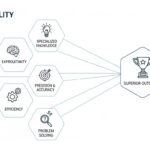Have you ever been at a planning retreat or brainstorming session and felt overwhelmed by the sheer number of ideas, driving everyone to frustration? This chaos, where too many ideas lead to confusion, is a common occurrence in many situations. It can often be alleviated using various problem-solving tools that help people quickly organize their thoughts and reach consensus. One effective tool is the SWOT analysis.
What does SWOT Analysis mean?
SWOT analysis is a strategic framework used to identify and evaluate an organization’s strengths, weaknesses, opportunities, and threats. By utilizing SWOT, organizations can make informed business decisions or develop effective strategies. This framework considers both internal and external factors that could influence the success or failure of a project, strategy, or business decision.
SWOT analysis can be applied to an entire organization, a specific product line, a single department, or even an individual. It helps in understanding internal and external factors that can affect the success or failure of a project or strategic initiative. During an annual planning retreat, the executive leadership team should use SWOT analysis to reach a consensus on the current state of the organization. This understanding can then be compared with the organization’s five-year vision to identify the three to five strategic initiatives required to bridge the gap.
When and Why to Use SWOT Analysis
SWOT analysis is often initiated at the beginning of, or as part of, a strategic planning process. It is a powerful decision-making aid that allows organizations to uncover previously unarticulated opportunities for success and highlight potential threats before they become problematic. By identifying a market niche where a business holds a competitive advantage, or by helping individuals map out a career path that leverages their strengths while mitigating threats, SWOT analysis proves invaluable. Learn what is a SWOT analysis, the four parts of analysis, and the template.
This type of analysis is most effective when it incorporates pragmatic recognition of business issues and concerns. As such, a SWOT analysis typically involves a diverse, cross-functional team that can share ideas and insights freely. The best results are obtained when the team uses real data and experiences, such as revenue or cost figures, to inform the analysis.
Applying SWOT in Planning Retreats
At an annual planning retreat, the imperative is to understand the current reality before deciding what needs to change. SWOT analysis provides a structured approach to evaluating the organization’s present situation. This method helps to streamline the discussion and avoid the chaos of too many ideas by focusing on concrete aspects of the organization. For example, in the context of a SWOT analysis, understanding the strengths and weaknesses of an organization also involves examining what is Diversity, Equity, and Inclusion (DEI meaning) to ensure comprehensive and equitable strategic planning.
Strengths and weaknesses should be viewed as internal factors that reflect how your organization compares to its competitors. Opportunities and threats relate to external factors, representing what is happening outside your organization that might impact it. Identifying factors in all four categories should be based on facts rather than speculation or wishful thinking. It’s crucial to face uncomfortable realities to accurately define your current situation.
Components of a SWOT Analysis
There are four elements for a SWOT analysis:
- Strengths: Internal attributes and resources that contribute to a successful outcome, such as a diverse product line, loyal customer base, or excellent customer service.
- Weaknesses: Internal factors and resources that hinder success, like a weak brand, excessive debt, or inadequate staffing and training.
- Opportunities: External factors that the organization can exploit to its advantage, such as favorable export tariffs, tax incentives, or new technologies.
- Threats: External factors that could jeopardize success, including increasing competition, declining demand, or supply chain uncertainties.
A SWOT matrix, typically a square divided into four quadrants, is used to organize these elements. Each quadrant represents one of the four components, allowing decision-makers to systematically list strengths, weaknesses, opportunities, and threats. Organizations or individuals conducting a SWOT analysis can utilize various templates that usually adhere to this four-quadrant format.
Detailed Examination of SWOT Elements
Strengths
When identifying strengths, focus on areas where your organization has a competitive advantage. For instance, if all your competitors have excellent websites with comprehensive product information and order tracking, then having a “great” website is not necessarily a strength. Avoid overrating your capabilities and use quantifiable and verifiable facts rather than empty proclamations. This is the time to acknowledge true strengths that come from overcoming challenges.
Weaknesses
Identifying weaknesses requires honesty and a willingness to confront uncomfortable truths. For instance, if your meetings often end with unanimous decisions that no one truly supports, this should be listed as a weakness. Understand what causes you to lose prospects and customers to competitors and where improvements are necessary. Evaluate your organization’s vision, mission, and values; if these are lacking, they should be included in your list of weaknesses.
Opportunities
Identifying opportunities involves looking at best practices, emerging trends, competitor successes, and external changes. For instance, new technology, government programs, or changing demographics can open new markets or enhance your competitive advantage. Consider how you can leverage your strengths or address your weaknesses in light of these opportunities. Think strategically about how to use social media, whether for creating loyal customers or attracting new employees.
Threats
Listing threats involves considering external factors that could negatively impact your organization. For instance, the increase in natural gas production has significantly affected coal producers more than environmental regulations. Consider what changes could affect your market or make your products and services obsolete. Extend your analysis to include suppliers, partners, and employees, and address threats realistically.
Prioritizing and Pruning SWOT Factors
A comprehensive SWOT analysis should not be cluttered with an excessive number of factors. Instead, focus on having open discussions to clarify, modify, combine, and eliminate items from your initial list. The goal is to prune and prioritize the factors to no more than three to five per category. One effective method for this process is the RightPage consensus-building tool.
Moving from Analysis to Action
Once your SWOT analysis is complete and you have identified three to five factors for each category, you can begin to develop action plans that:
- Capitalize on strengths
- Minimize weaknesses
- Take advantage of opportunities
- Manage risks associated with threats
This transition from analysis to action is where the true value of a SWOT analysis lies. It provides a clear framework for turning insights into strategic initiatives and practical steps that can guide your organization toward achieving its goals.
SWOT analysis is a powerful tool for understanding and planning for success by identifying and evaluating an entity’s internal and external factors. By carefully analyzing strengths, weaknesses, opportunities, and threats, you can make informed decisions and create effective strategies to navigate challenges and capitalize on opportunities. Whether applied to an entire organization, a specific product line, a single department, or an individual, SWOT analysis helps to streamline the decision-making process and align your strategic initiatives with the realities of the competitive environment.












